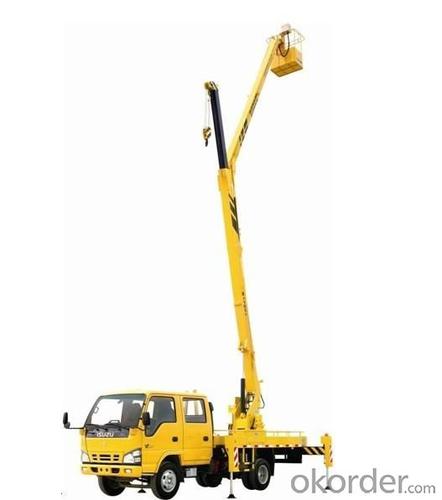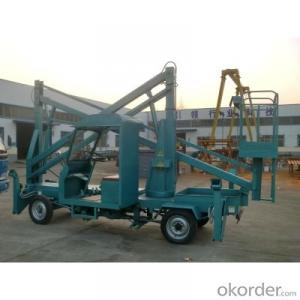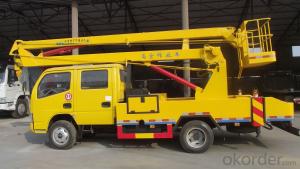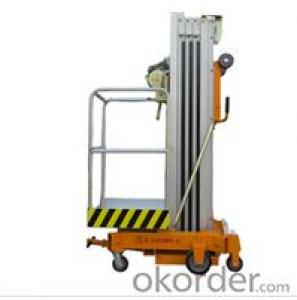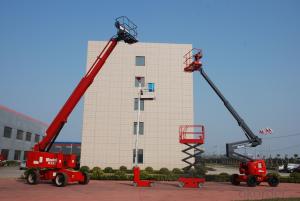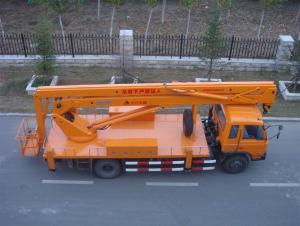Aerial Lift Work Truck
- Loading Port:
- China Main Port
- Payment Terms:
- TT or L/C
- Min Order Qty:
- -
- Supply Capability:
- 10 Sets Per Month m.t./month
OKorder Service Pledge
OKorder Financial Service
You Might Also Like
Details of Aerial Work Truck
Model JQ5050JGK-12 JQ5050JGK-14 JQ5060JGK-16 JQ5060JGK-18
1.Platform
Max. Rated. capacity 200kg(2 persons) 200kg(2 persons) 200kg(2 persons) 200kg(2 persons)
Max. Working Height 12m 14m 16m 18m
10.3m 12.3m 16.5m
Max. Working Radius 6m 6.5m 7m 8m
2.Boom
Upper boom lifting angle 70° 70° 70° 70°
Lower boom lifting angle 70° 70° 70° 70°
Turn around angle 360° 360° 360° 360°
3.Outrigger
Lateral span 2750mm 2750mm 3250mm 3250mm
Outriggers Adjustment Individual adjustment Individual adjustment Individual adjustment Individual adjustment
4.Chassis
Type JX1060TSG23 EQ1071TJ3
Engine power 70KW 67.6KW 88kw
Engine type 4100QBZL 4100QBZL JX493ZLQ3 CY4102BZLQ
Displacement(ml) 3707ml 3856 3856
Crews 5 persons 5 persons 5 persons 3 persons
Dimensions(mm) 6750*1950*2960 7400*1890*3110 7400*2010*3100 8000*2200*3400
Wheel Base (mm) 3300 3360 3800 3856
Wheel trade(front/back)(mm) 1500/1466 1385/1425 1750/1586 1750/1586
Fuel Diesel oil Diesel oil Diesel oil Diesel oil
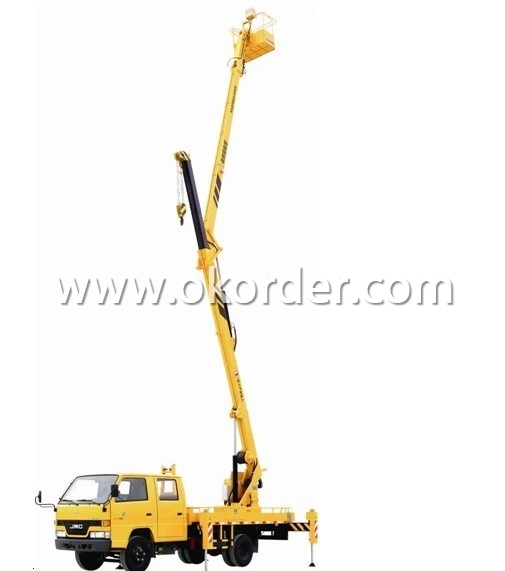
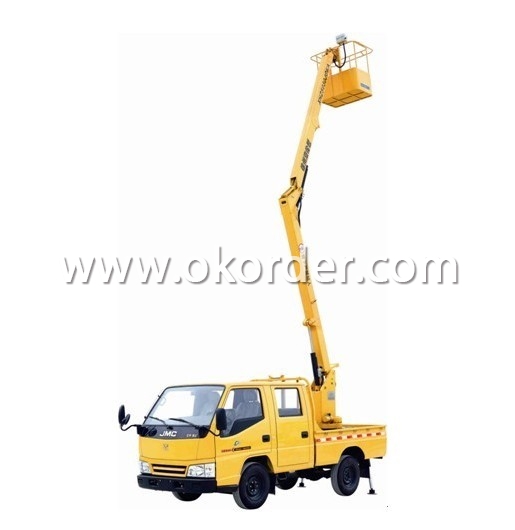
- Q: This question asks about the criteria for determining when a building hoist has reached the end of its useful life and should be replaced.
- <p>The lifespan of a building hoist is determined by several factors including its design, materials, usage, maintenance, and compliance with safety standards. Regular inspections and maintenance are crucial to assess the hoist's condition. A hoist should be replaced when it shows significant wear, has been in service beyond the manufacturer's recommended lifespan, or fails to meet safety standards. Additionally, any hoist that has been involved in an accident or has undergone major repairs may need to be replaced to ensure safety. Consulting the manufacturer's guidelines and local regulations can provide specific information on when a hoist should be retired.</p>
- Q: Is it possible to utilize a building hoist for elevating construction materials?
- <p>Yes, building hoists are commonly used in construction to lift materials. They are designed to transport heavy materials, such as bricks, cement, and steel, vertically between floors. These hoists are crucial for efficient construction, especially in high-rise buildings, as they reduce manual labor and increase safety by minimizing the need for workers to carry heavy loads up ladders or stairs.</p>
- Q: This question asks if a building hoist is capable of lifting heavy objects.
- <p>Yes, a building hoist is specifically designed to lift large objects. It is a type of crane used in construction to move heavy materials and equipment to different levels of a building under construction. Building hoists can handle a significant weight, but the exact capacity depends on the specific model and its design specifications. They are essential for efficient construction processes, ensuring the safe and effective transportation of materials within the construction site.</p>
- Q: How does the driver of the construction elevator do the search for a sudden power failure
- When the elevator is running in an abnormal condition, it should stop immediately and take effective measures to bring the ladders down to the ground floor. When the electric is out of control in operation, the stop button should be pressed immediately. The stop button is not allowed until the failure is ruled out.
- Q: Is it possible to utilize a single-rope lifting system in both indoor and outdoor environments, especially during cold weather?
- <p>Yes, a single-rope lifting system can be used both indoors and outdoors, including in cold weather conditions. However, it's crucial to consider the specific requirements and limitations of the system and the environment. Cold temperatures can affect the strength and flexibility of the rope, as well as the performance of other components like motors and hydraulic systems. It's essential to use appropriate materials designed for low-temperature operation, ensure proper maintenance, and follow safety guidelines to prevent damage or accidents. Always consult the manufacturer's recommendations for operating in extreme weather conditions.</p>
- Q: What are the pros and cons of utilizing hydraulic fluid within the system of a building hoist?
- <p>The advantages of using hydraulic fluid in a building hoist include smooth and controlled lifting, which reduces the risk of accidents. It also offers a compact design due to the high power-to-weight ratio of hydraulic systems. Additionally, hydraulic systems are known for their durability and low maintenance requirements. However, there are disadvantages such as the potential for leaks, which can be hazardous and costly to repair. The systems can also be sensitive to temperature changes, which might affect performance. Lastly, hydraulic fluids can be environmentally harmful if not properly managed, posing disposal challenges.</p>
- Q: Describe the key differences between electric and manual building hoists.
- <p>Electric building hoists are powered by electricity and can lift heavy loads quickly and efficiently. They are automated, reducing manual labor and increasing productivity. On the other hand, manual hoists require human effort to operate, making them slower and less efficient. They are less costly but demand more physical labor, which can lead to fatigue and potential accidents. Electric hoists are suitable for large-scale construction projects, while manual hoists are often used in smaller, more confined spaces where electricity might not be readily available or where the load is not excessively heavy.</p>
- Q: This question asks about frequent issues related to building hoists and seeks solutions for these problems.
- <p>Common problems with building hoists include mechanical failures, electrical issues, overloading, and safety malfunctions. Mechanical failures can be fixed by regular maintenance, lubrication, and replacement of worn parts. Electrical problems may require checking wiring, connections, and replacing faulty components. Overloading can be prevented by strictly adhering to the hoist's weight limit and using load indicators. Safety malfunctions, such as brake failure, require immediate attention and may involve replacing brake pads or overhauling the braking system. Always ensure that hoists are used according to the manufacturer's guidelines and are regularly inspected by qualified personnel to prevent accidents and ensure safe operation.</p>
- Q: This question asks for guidance on selecting the appropriate lifting equipment based on specific requirements.
- <p>Choosing the right type of lifting equipment involves assessing several factors: the weight and size of the load, the environment in which the lifting will occur, and the specific tasks to be performed. Consider the load capacity required and ensure the equipment can handle the heaviest item you need to lift. Evaluate the space constraints and accessibility of the lifting area. Select equipment that is safe for the environment, such as explosion-proof models for hazardous areas. Consider the need for mobility and whether the equipment should be portable or fixed. Finally, consult with equipment manufacturers or industry experts to ensure you choose equipment that meets all safety standards and is suitable for your specific lifting needs.</p>
- Q: This question asks about the time required to install a building hoist, a device used for lifting materials in construction.
- <p>The time it takes to install a building hoist can vary significantly based on factors such as the type and size of the hoist, the specific building requirements, and the experience of the installation team. On average, it can take anywhere from a few hours to a couple of days. For smaller hoists, installation might be completed within a day, while larger, more complex systems could take longer. It's important to note that safety checks and regulatory compliance verifications are also part of the process, which can add to the total installation time.</p>
1. Manufacturer Overview
| Location | JIANGSU,CHINA |
| Year Established | 1998 |
| Annual Output Value | Above US$10 Million |
| Main Markets | CHINA |
| Company Certifications | ISO 9001:2000; |
2. Manufacturer Certificates
| a) Certification Name | |
| Range | |
| Reference | |
| Validity Period |
3. Manufacturer Capability
| a) Trade Capacity | |
| Nearest Port | Shanghai |
| Export Percentage | 0.6 |
| No.of Employees in Trade Department | 300 People |
| Language Spoken: | English;Chinese; |
| b) Factory Information | |
| Factory Size: | Above25,000square meters |
| No. of Production Lines | Above 1 |
| Contract Manufacturing | OEM Service Offered;Design Service Offered |
| Product Price Range | Average |
Send your message to us
Aerial Lift Work Truck
- Loading Port:
- China Main Port
- Payment Terms:
- TT or L/C
- Min Order Qty:
- -
- Supply Capability:
- 10 Sets Per Month m.t./month
OKorder Service Pledge
OKorder Financial Service
Similar products
Hot products
Hot Searches
Related keywords



